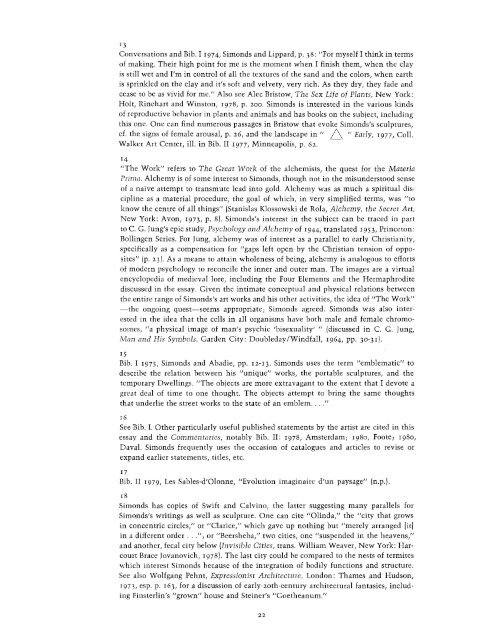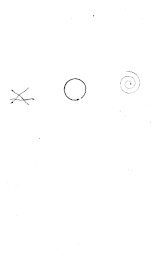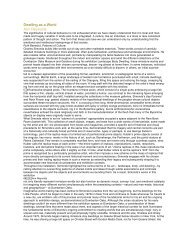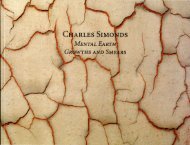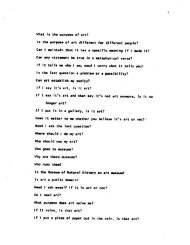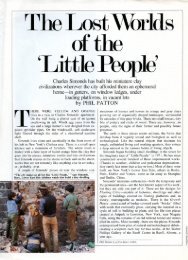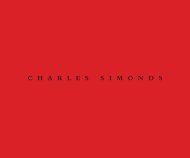Read Catalog - Charles Simonds
Read Catalog - Charles Simonds
Read Catalog - Charles Simonds
Create successful ePaper yourself
Turn your PDF publications into a flip-book with our unique Google optimized e-Paper software.
13<br />
Conversations and Bib. I 1974, <strong>Simonds</strong> and Lippard, p. 38: 1 'For myself I think in terms<br />
of making. Their high point for me is the moment when I finish them, when the clay<br />
is still wet and I'm in control of all the textures of the sand and the colors, when earth<br />
is sprinkled on the clay and it's soft and velvety, very rich. As they dry, they fade and<br />
cease to be as vivid for me." Also see Alec Bristow, 'The Sex Life of Plants, New York:<br />
Holt, Rinehart and Winston, 1978, p. 200. <strong>Simonds</strong> is interested in the various kinds<br />
of reproductive behavior in plants and animals and has books on the subject, including<br />
this one. One can find numerous passages in Bristow that evoke <strong>Simonds</strong>'s sculptures,<br />
cf. the signs of female arousal, p. 26, and the landscape in" "Early, 1977, Coli.<br />
Walker Art Center, ill. in Bib. II 1977, Minneapolis, p. 62.<br />
14<br />
"The Work" refers to 'The Great Work of the alchemists, the quest for the Materia<br />
Prima. Alchemy is of some interest to <strong>Simonds</strong>, though not in the misunderstood sense<br />
of a nai:ve attempt to transmute lead into gold. Alchemy was as much a spiritual discipline<br />
as a material procedure, the goal of which, in very simplified terms, was "to<br />
know the centre of all things" (Stanislas Klossowski de Rola, Alchemy, the Secret Art,<br />
New York: Avon, 1973, p. 8). <strong>Simonds</strong>'s interest in the subject can be traced in part<br />
to C. G. Tung's epic study, Psychology and Alchemy of 1944, translated 195 3, Princeton:<br />
Bollingen Series. For Jung, alchemy was of interest as a parallel to early Christianity,<br />
specifically as a compensation for "gaps left open by the Christian tension of opposites"<br />
(p. 23 j. As a means to attain wholeness of being, alchemy is analogous to efforts<br />
of modern psychology to reconcile the inner and outer man. The images are a virtual<br />
encyclopedia of medieval lore, including the Four Elements and the Hermaphrodite<br />
discussed in the essay. Given the intimate conceptual and physical relations between<br />
the entire range of <strong>Simonds</strong>'s art works and his other activities, the idea of "The Work"<br />
-the ongoing quest-seems appropriate; <strong>Simonds</strong> agreed. <strong>Simonds</strong> was also interested<br />
in the idea that the cells in all organisms have both male and female chromosomes,<br />
"a physical image of man's psychic 'bisexuality' " (discussed in C. G. Jung,<br />
Man and His Symbols, Garden City: Doubleday/Windfall, 1964, pp. 30-31).<br />
IS<br />
Bib. I 1975, <strong>Simonds</strong> and Abadie, pp. 12-13. <strong>Simonds</strong> uses the term "emblematic" to<br />
describe the relation between his "unique" works, the portable sculptures, and the<br />
temporary Dwellings. "The objects are more extravagant to the extent that I devote a<br />
great deal of time to one thought. The objects attempt to bring the same thoughts<br />
that underlie the street works to the state of an emblem .... "<br />
16<br />
See Bib. I. Other particularly useful published statements by the artist are cited in this<br />
essay and the Commentaries, notably Bib. II: 1978, Amsterdam; 1980, Foote; 1980,<br />
Daval. <strong>Simonds</strong> frequently uses the occasion of catalogues and articles to revise or<br />
expand earlier statements, titles, etc.<br />
I7<br />
Bib. II 1979, Les Sables-d'Olonne, "Evolution imaginaire d'un paysage" {n.p.).<br />
18<br />
<strong>Simonds</strong> has copies of Swift and Calvina, the latter suggesting many parallels for<br />
<strong>Simonds</strong>'s writings as well as sculpture. One can cite "Olinda," the "city that grows<br />
in concentric circles," or {/Clarice/' which gave up nothing but {/merely arranged [it]<br />
in a different order ... "; or {/Beersheba," two cities, one "suspended in the heavens,"<br />
and another, fecal city below {Invisible Cities, trans. William Weaver, New York: Harcourt<br />
Brace Jovanovich, 1978). The last city could be compared to the nests of termites<br />
which interest <strong>Simonds</strong> because of the integration of bodily functions and structure.<br />
See also Wolfgang Pehnt, Expressionist Architecture, London: Thames and Hudson,<br />
1973, esp. p. 163, for a discussion of early-2oth-century architectural fantasies, includ-<br />
Finsterlin's {/grown" house and Steiner's "Goetheanum."<br />
22


